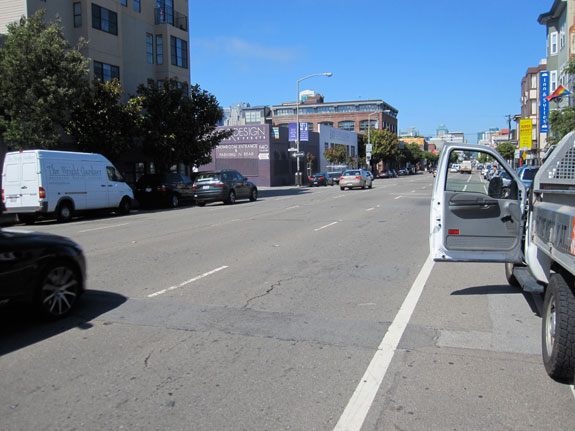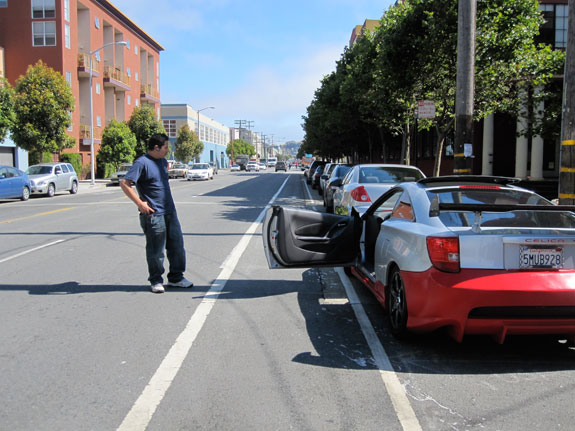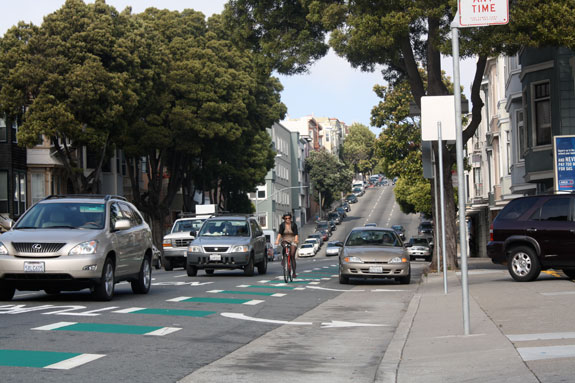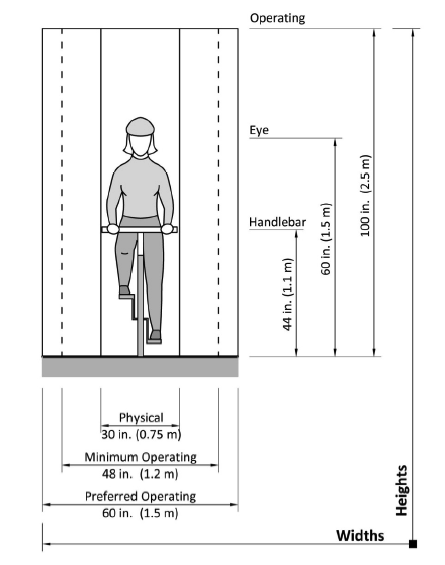
As one of the certified bicycle safety instructors working with San Francisco’s Bike Ed program, the most important safety concept we try to get across to our students is that cyclists should never ride closer than 4 feet from any parked car. The reason is that getting 'doored' is the single most common cause of injury by motor vehicle users to people riding bikes in San Francisco.
People have been injured and even killed by riding in what is ostensibly a ‘safe’ space. Suddenly a door opens in front of them and they either have to swerve into motor traffic or hit the door itself.
Inevitably a student asks us, “But what about the bike lanes I see all over the city? A lot of them are totally within the 'door zone.' Where am I supposed to ride if the bike lane isn’t even safe?”
It’s a good question. Many of the city’s bike lanes have been built so that there is no clearance whatsoever between an open door and a passing cyclist. In the worst case scenario, a person with an older American car (Cadillacs have the longest doors) parks lazily, 2-3 feet from the curb. When they open their door, it can block the entire bike lane.
You might ask, isn’t it the responsibility of the driver to look over the shoulder before opening their door? And you would be right. CVC code 22517 requires that a vehicle occupant check for traffic before opening a door. Yet in the real world, people open their doors without checking all the time. And a person on a bicycle cannot reasonably be expected to look into every car to check whether there is someone inside. Under state law, cyclists have the right to ride where it is safe, which courts have affirmed is outside the dangerous door zone (CVC 21202).

So why are we designing bicycle facilities that are dangerous to use? According to Caltrans chapter 1000 design manual [pdf], a bike lane adjacent to on-street parking must be at least 1.5m (just under 5 feet) wide. The minimum parking lane width is 7 feet (San Francisco Municipal Transportation Agency standards require 8 feet). Essentially that means if you are going to follow widely recommended safety practice and ride out of the door zone, but still in the bike lane, you have about one foot left to maneuver.

On San Francisco’s Fell St, the city’s designated east to west bicycle route, despite the new green paint, if you want to ride a bike safely, you are put in the unsafe position of staying within a one foot strip between the door zone and the motor traffic zooming by to the right.
Even if you are Kate Moss on a bicycle, you need more than one foot of width to safely maneuver. The American Association of State Highway and Transportation Officials (AASHTO) recommends that cyclists are given at least 4 feet of width (preferably 5 feet) to ride safely. Even if you are an expert at riding your bicycle in exactly a straight line, the likelihood is that you will veer into the door zone, or into the traffic lane at some point along your 3 block running of the gauntlet. If you follow official bicycle safety guidance, you should technically take the next lane over. But drivers see an empty bike lane and a "car lane" blocked by a cyclist in front of them and you have a perfect recipe for road rage.
So what is the solution? First off, bicycle design standards need to be changed to require cross hatch markings that extend 4 feet from a parked car so that even novice cyclists realize this a "no riding" area. If there is insufficient width on the street for a buffer and a bike lane, then a parking or travel lane needs to be removed. If providing for the safety and dignity of all road users is politically infeasible, then the bike lane itself needs to be removed and replaced with sharrows indicating that cyclists should take the travel lane.
It is no longer acceptable to lure people onto bicycles with a network of bicycle lanes that look inviting, but in reality can cause injury or death when used as directed. Our bicycle infrastructure design and our bicycle safety curricula should complement, not contradict, one other.






